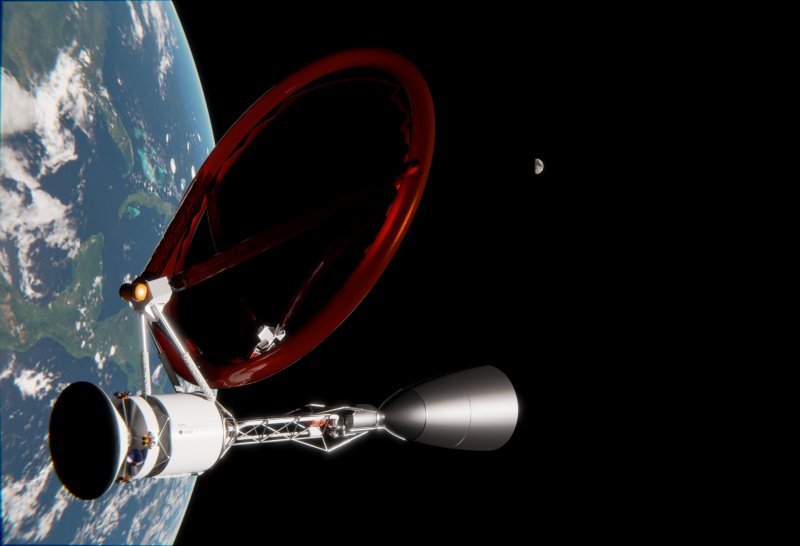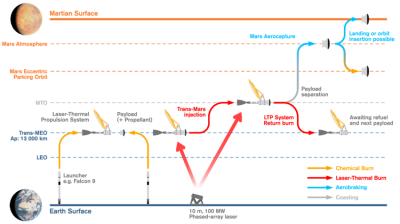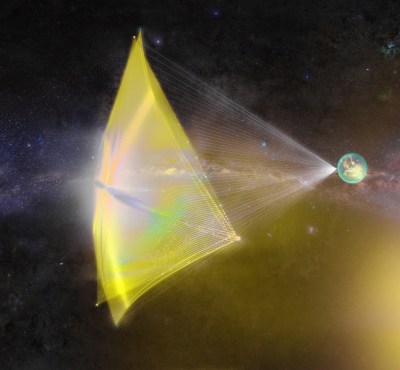
There are many wonderful places we’d like to visit in the universe, and probably untold numbers more that we haven’t even seen or heard of yet. Unfortunately…they’re all so darn far away. A best-case-scenario trip to Mars takes around six months with present technology, meanwhile, if you want to visit Alpha Centauri it’s a whole four lightyears away!
When it comes to crossing these great distances, conventional chemical rocket technology simply doesn’t cut the mustard. As it turns out though, lasers could hold the key to cutting down travel times in space!
45 Days To Mars on the Laser
Laser thermal propulsion is a relatively simple concept, and could get our spacecraft travelling our celestial neighborhood quicker than ever. A powerful laser beam fired from Earth targets a large heat exchanger aboard the craft, through which is pumped a propellant. As the heated propellant expands, it’s ultimately exhausted out of a nozzle in much the same way as in a traditional rocket. It’s also similar to the concept of nuclear thermal propulsion, but instead of using heat from a nuclear reaction, it relies on externally-supplied laser energy.
A recent paper suggests such a propulsion system could run at a specific impulse of around 3000 seconds. This is essentially a measure of how much thrust a engine develops per mass of fuel. At 3000 seconds, a laser thermal propulsion system could be said to be at least 12 times as fuel efficient in thrust terms as the solid rocket boosters (SRBs) on the Space Shuttle.

This allows a laser thermal propulsion to achieve far greater changes in velocity with less fuel, which gives a space mission the ability to send payloads farther and faster. Calculations show that with an idealized mission plan, a payload of around 1000 kg could be sent to Mars in just 45 days, far quicker than the usual 6-7 months possible in typical chemical-fueled missions.

The technology involved is complex, as you’d expect. A large laser array with power on the order of 100 MW would be required for the mission. The spacecraft itself would be launched out of the atmosphere on a conventional chemical rocket, whereupon it would separate and reveal a large inflatable parabolic reflector. The ground-based laser would then fire for up to an hour, using adaptive optics to counter the effect of the Earth’s atmosphere on the beam. The parabolic reflector on the spacecraft would then focus the energy on to a chamber to heat hydrogen propellant that would be expelled out of a nozzle at great velocity, providing thrust.
If so desired, the spacecraft could be designed to release the payload capsule on its path towards Mars, with the laser thermal propulsion unit separating off and returning to a stable Earth orbit for refueling. This has the benefit that the propulsion system itself could be used multiple times in quick succession to loft payloads far beyond Earth.
Such a system has one major flaw that stands out. While a laser on Earth is used to accelerate the spacecraft to great velocity, there is no corresponding laser array on Mars that can decelerate the craft on arrival. Nor is using chemical propulsion a practical way to slow down, as this would take up far too much of the craft’s useful payload. Researchers instead have determined that a very careful aero-braking maneuver in the Martian atmosphere could be used to slow an arriving craft. However, it’s a delicate operation that must be executed flawlessly to ensure success.
Overall, such a system could be readily developed in the near term. While nobody has a 100 MW laser array just lying around, modern fiber optic laser technologies mean that such a power figure is not outside the realms of possibility. Similarly, much work would be required to create a reliable laser thermal spacecraft and ground system capable of sending payloads in useful directions in space not solely limited by the relative positions of spacecraft and ground laser.
Ride The Laser To The Stars
If you want to go as far as our nearest star, Alpha Centauri, you’ll need to travel even faster. Even going at the speed of light, it would take four years to get there. Thus, a probe intending to travel that far would want to be going as close to that speed as is possible to make it there in a reasonable period of time.
Laser sails may just hold the answer to this problem. They rely on the concept of photon radiation pressure, where light hitting a surface actually creates pressure and pushes it along. They’re referred to as sails because the concept is exactly the same as that of a sailing ship of centuries past. Instead of cloth and wind, though, a laser sail substitutes in advanced nano-materials and powerful laser light.

Recent research suggests a laser sail on the scale of a few meters could propel a gram-weight craft at velocities up to 0.2 times the speed of light. This would enable reaching Alpha Centauri in around 20 years, rather than the tens of thousands of years it would take with conventional rocketry.
The concept would require the use of a sail made of exceedingly thin sheets of materials like aluminium oxide, silicon nitride, and molybdenum disulfide. Measuring thousands of times thinner than a sheet of paper, the sail would have to be strong enough not to tear, and also be capable of dissipating heat so as not to melt from the power of the laser propelling it along.
Advanced nano-patterning of the sail would be key to achieving this goal. The idea is to produce a sail with high reflectivity to maximize acceleration due to photonic pressure, while also maintaining high thermal emissivity to keep the sail cool enough not to melt. With a 100 GW laser array firing at the sail, that’s no mean feat. Much like a conventional sail on a sailing ship, the material would be allowed to billow out under the pressure of the incoming light. This reduces the chance of tears significantly.
At best, the sail would only be able to carry a tiny payload weighing a few grams. It’s hoped that advanced fabrication methods could create a microprocessor, cameras, and communication hardware for the probe that would be able to communicate over the vast distances between Alpha Centauri and Earth.
It’s a bold plan, and one that could enable space research to tackle subjects farther afield than ever before. However, the challenges involved are great. The requirement for hugely powerful laser arrays is beyond our current capabilities, and the issue of materials still needs to be solved. Furthermore, any message sent from a probe at Alpha Centauri would take four years to arrive back on Earth, so communications issues present themselves as well.
Regardless, the research run thus far by Breakthrough Initiatives shows that laser sail concepts aren’t necessarily just a matter for science fiction. With the right investment and development, they could prove to be a useful propulsion method for research craft one day in the future.
Conclusion
Unlike other seemingly sci-f tech, like ion thrusters, these laser propulsion methods are still quite a ways off being fielded in real space missions. There are huge challenges to overcome, and it also bears sparing a thought for any birds or other unlucky wildlife that finds itself in the beam of a megawatt- or gigawatt-class laser.
However, if we are to open up the heavens, it’s going to require more than our existing technology can achieve. Thus, these projects, or perhaps other fancy new ideas, could one day take us far beyond our own solar system.
0 Commentaires